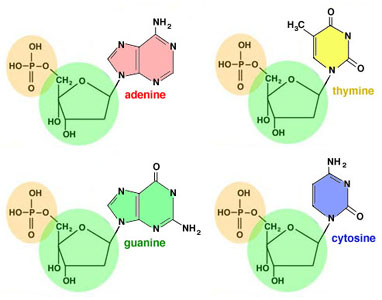DNA
DNA, desoxyribonucleic acid, is the
major component of chromosomes.
It is a long, threadlike macromolecule made up of a large number of smaller
units, the nucleotides.
 Each nucleotide
has three constituents:
Each nucleotide
has three constituents:
• A sugar: desoxyribose
• A phosphate group
• A base out of four possible ones:
- adenine (A)
- guanine (G),
- cytosine (C)
- thymine (T).

The backbone is made up of sugars
linked by phosphate groups. Each sugar is linked to a base. These bases can
form a weak bond, so that it is possible for two strands to form a double helix,
discovered by Watson and Crick in the 50s.
 DNA
contains all the genetic information needed, which is written in the form of
a code. This code is universal and is found in all living organisms. The sequence
of nucleotides with their base forms the code: each set of three nucleotides
(a codon) encodes an amino acid. The nucleotides are represented by the capital
letter of their base. Hence, an example of a codon would be AGC.
DNA
contains all the genetic information needed, which is written in the form of
a code. This code is universal and is found in all living organisms. The sequence
of nucleotides with their base forms the code: each set of three nucleotides
(a codon) encodes an amino acid. The nucleotides are represented by the capital
letter of their base. Hence, an example of a codon would be AGC.
A gene is a certain segment of DNA
with more than one codon. It gives specific instructions for the production
of one protein. The coding sequence of a gene is, on average about 1000 nucleotides
long.
If a cell or an organism
needs a certain type of protein, the cell 'looks
up' the structure in the nucleus, a bit like we look up a recipe in a cook book
. It then synthesises it according to the code, using amino acids as building
blocks.
Even though EVERY cell in an organism contains the same chromosomes and hence
genetic information, not all cells synthesise all proteins. Cells specialise
so that for example pancreatic cells produce insulin and not saliva.
We see that genes are regulated. There is a 'block' that prevents different
proteins to be synthesised in specific cells. Either a gene is permanently shut
down and can never be encoded, or a cell never requests the production of a
protein, so that the gene is never used.
By traditional breeding we cannot change this, i.e.
it is not possible to 'destroy' this block and make cells synthesise proteins
that a particular part of the organism does not need.
This is where genetic engineering comes in. It is possible to fool the cell
and change the position of genes or even bring in new genes from another species.
 Each nucleotide
has three constituents:
Each nucleotide
has three constituents:
 DNA
contains all the genetic information needed, which is written in the form of
a code. This code is universal and is found in all living organisms. The sequence
of nucleotides with their base forms the code: each set of three nucleotides
(a codon) encodes an amino acid. The nucleotides are represented by the capital
letter of their base. Hence, an example of a codon would be AGC.
DNA
contains all the genetic information needed, which is written in the form of
a code. This code is universal and is found in all living organisms. The sequence
of nucleotides with their base forms the code: each set of three nucleotides
(a codon) encodes an amino acid. The nucleotides are represented by the capital
letter of their base. Hence, an example of a codon would be AGC.